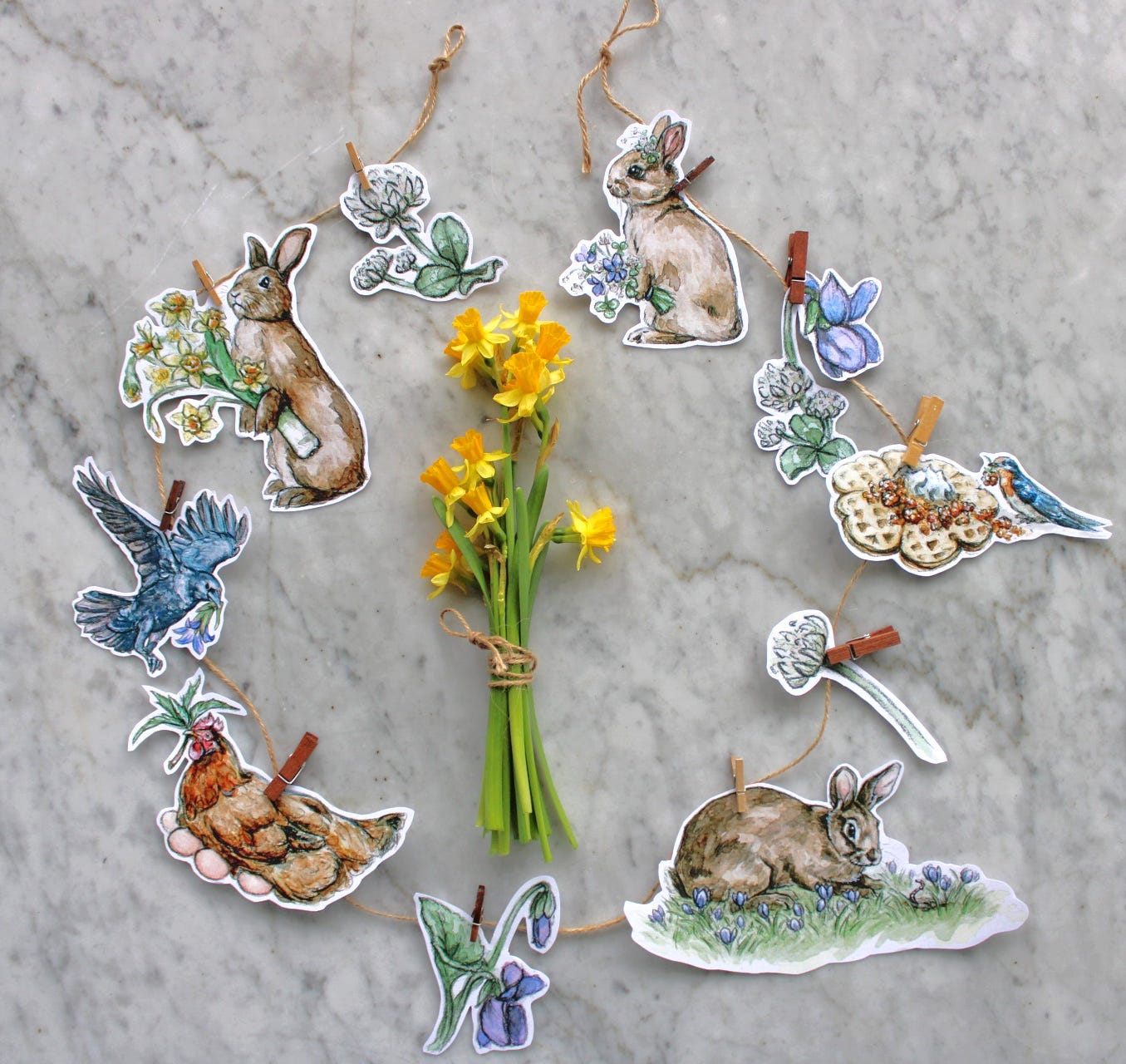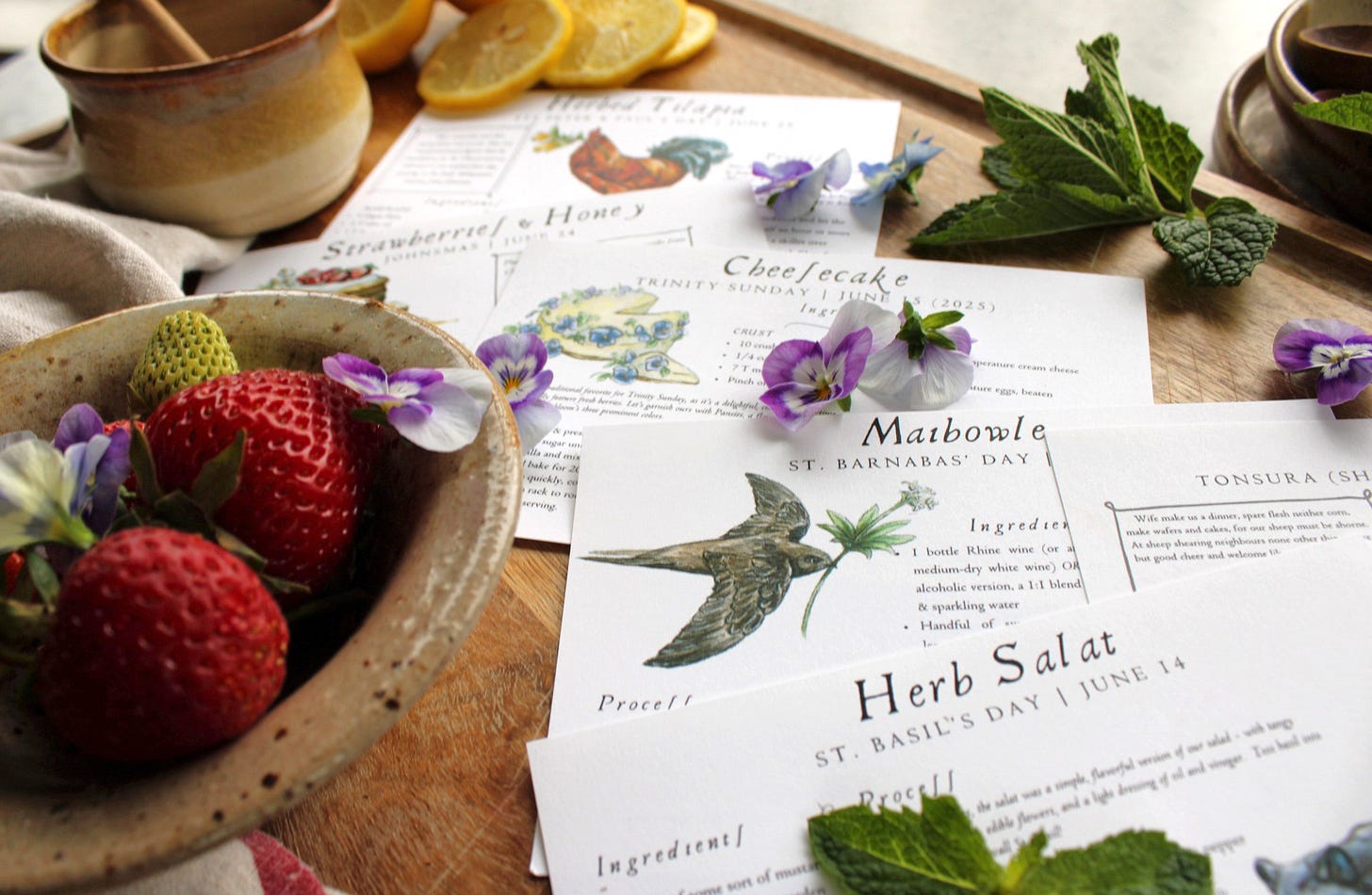Book of Hours: Begin
Two steps for getting started with your Liturgical Year binder
When yew is out, then birch comes in,
And many flowers beside,
Both of a fresh and fragrant kin,
To honour Whitsuntide.Green rushes1 then, and sweetest bents,
With cooler oaken boughs,
Come in for comely ornaments,
To re-adorn the house.
Thus times do shift; each thing his turn does hold;
New things succeed, as former things grow old.Excerpt from “Ceremonies For Candlemas Eve” by Robert Herrick (17th c)
Welcome to the first in a series of posts to help us build our Liturgical Year binders - our own Book of Hours - with each other! We’ll start here, with the basics, and then add more pieces in as we go…so that you can personalize your binder and figure out what works for you over time.
Pax+bonum, Kristin.
Welcome to a fresh, new (yet ancient) season of the Church year! This second season of Ordinary Time - also called the Season After Pentecost, Pentecostide, Trinitytide2, etc. - is long. It will see us through all of summer and fall, and we won’t turn to a new liturgical season until Advent comes.
I know this long stretch of time can seem overwhelming…but, honestly, this is my favorite season of the liturgical calendar. I’ll be sharing more about that soon, but in the meantime…entering into this Spirit-driven season feels like the perfect time to tackle our Liturgical Binders as a community.
If you’ve been here for a bit, you know that I love creating art and resources to help build up our Liturgical Year binders…but it’s time to go back to basics, taking that big stack of files or papers and sorting them into something we can use.
Rather than bombarding you with a load of information & ideas all in one post, let’s go at a gentle pace and work together a little bit at a time…
A REMINDER
There’s no ‘perfect system’ as all of us - in our varied life situations - sort through the myriad of resources we may lean on for liturgical living. This isn’t about a system, after all: the tools we use are here to help us better live into our calling in Christ. They’re not ends unto themselves.
This is something I have to frequently call to mind, since I love a good rabbit-hole and can easily turn a spiritual practice into a mental-museum! We’re looking for transformation - not collection. (Again, I’m preaching to myself!)
When Jesus and his disciples were walking through the grainfields on the Sabbath, snacking on wheat berries, they were confronted by the Pharisees about this apparent breaking of the Sabbath.
Jesus tells the Pharisees (and all of us), though, that…
The Sabbath was made for man, not man for the Sabbath.
Mark 2:27
This is how I try to approach the liturgical year. Though the Sabbath was instituted by God, and the liturgical calendar has been an ongoing vehicle of formation developed through centuries of Church tradition, I think we can apply a similar push-back to our own tendencies to “check all the boxes” in the calendar.
If we walk through the Church year’s sacred time in a legalistic mindset, we’re more easily overwhelmed, more rigid in our expectations & celebrations, and more likely to feel shame or disappointment when we’re “not doing it right.”
Sometimes, when our family/community celebrates Candlemas, we bring out all the bells & whistles with a crepe-making buffet, homemade candles, and more.
Other times, the best I can do is a quick prayer as we order pizza. And still other times, I remember that I missed Candlemas just as my head hits the pillow.
It’s okay.
This is one of the beautiful, humbling things about the Cloud of Witnesses: Candlemas - and every other holy day in the year - doesn’t rely on me. What freedom, right?!
We get to inhabit the sacred tory of Jesus in our own lives and landscapes. The Church year is a gift of formation, not a rigid system that relies on our performance. It’s a calendar that exists to help us live into Christ’s salvific work - we are not made to exist for it, and the sacred Story it retells is not dependent on us.
So, as we build up our binder of liturgical year resources, let’s accept the grace freely given to us; let’s receive the permission to start imperfectly & incompletely, make changes where we need to…and order pizza.
STEP 1: COLLECT
As we begin building up our Liturgical Binders together, the first prompt is a big one, but a fun one…
…ready?
» Collect the summertime stuff that inspires you «
Magazine clippings for strawberry shortcake recipes. Photos from previous summers. Crayon pictures drawn by your kids. Church bulletins, poetry, coloring pages, books, music. Print out any liturgical resources that have been hanging out in a computer file folder, and add the summertime ones to your pile.
As you’re sifting through everything, you’ll find other items - whether specifically liturgical resources or other inspiring seasonal ephemera. Save those in a “to do” pile for later…right now, we’re going to focus on summer.
STEP 2: FIND BINDER SUPPLIES
My Book of Hours system has changed a lot over the years - I started3 with one binder, separated by tabs into seasons…and that’s where we’ll start together, too.
Now that you have a pile of summertime inspiration and resources - both liturgical and not - keep on the lookout for binder-building supplies.
There’s no need to over-complicate or get spendy with this, I promise! Whether you find a binder & other office supplies at a thrift store or order particular tools, all of this is intended to help you distill that big pile of inspiration into something that you can lean on - and add to, and subtract from - year after year.
To give you a sense of what I’ve found personally helpful in building my binder, I have a list for you: but remember, these aren’t required supplies!
I’m not an affiliate of any of the companies I’ve linked here - I’m just sharing links for some of these products because they’re the ones I like to use. Find what works for you, and ditch the tools that don’t!
I like to use regular ol’ binders (for 8.5 x 11 inch sheets) that have interior pockets as well as exterior pockets (for inserting cover pages)
Tabbed sheet protector dividers
These are super handy - each sheet protector is tabbed, so I use these for my feast-day cover pages within each binder
Sheet protectors
I use these if I want to have pockets for inserting multiple copies of something (like coloring pages or handouts, so that I already have copies on-hand) or protecting the paper (handy for recipes that may get messy!)Recipe card protectors
In case you happen upon any hand-illustrated recipe cards and want to stow them in your binder, these are super helpful - they fit two 4 x 6 inch cards per page and help protect them from kitchen messesRepositionable tabs
These help me continue to make smaller groups of resources within larger categoriesPockets
When I cut out garlands, paper scenes, etc., I pop all of these into a labeled binder pocket so that I can re-use them year after year. I just use plain manila envelopes and 3-hole-punch them, but you can also find binder envelopes.Having a pen pouch with 3-ring holes helps me to always have my writing utensils with me. I like to move the pencil pouch to my current “active” binder so that I can easily transfer my tools to the new season.
Inside the pouch, these are some of the bits & bobs floating around…
Pencils/Pens/Highlighters
Use whatever works for you. I used to try to do all sorts of elaborate, color-coded highlighting systems for all my notes, but I’ve totally given up on thatHole reinforcement stickers
These save the day when old papers get torn or wornTape
I like to use washi tape & switch out colors for the season, but I’m a bit over the top
What am I forgetting? What supplies would you want in your binder?
WORK TOGETHER!

I’ll be back with the next few steps shortly…in the meantime, have fun with these first two prompts, and be sure to lean on our wonderful Hearthstone Fables community members for more ideas!
Feel free to pop questions & thoughts into the comments here - and also hop over to our subscriber Chat, where you can discuss back and forth, and share pictures. Let’s encourage each other in this process!
Talk soon, kindred spirits. Happy Ordinary Time!
Pax et bonum,
Kristin
Until recently, Pentecost commonly had an Octave - ending just before Trinity Sunday (the Sunday following Pentecost). This invited more attentiveness to the Holy Spirit’s personhood in the Trinity, and the earlier names of Ordinary Time II (Season After Pentecost, Trinitytide) reflected that.
Over the years, that one binder morphed into separate binders for each liturgical season…then, crazily, file boxes for each season. I’ve mellowed and found binders much less cumbersome than big boxes, so now I keep a separate binder for each month of the year, plus one for movable feasts. Starting with one binder is the best way to go, though!










My dear friend, I read and then re read, I stopped and I pondered. Your thoughts and the feelings behind your words about the liturgical calendar and how to start living it, gave me a happy heart. We get to…what a vital distinction. Grace freely given. I particularly appreciate the verse at the beginning which reminds me that each season or feast holds gifts of its own and being mindful of that is a big part of the equation. Thank you for the advice and instructions.
Wow! I’ve never thought to create a liturgical year binder—what a great idea! This is right up my alley :) Thank you so much for this!